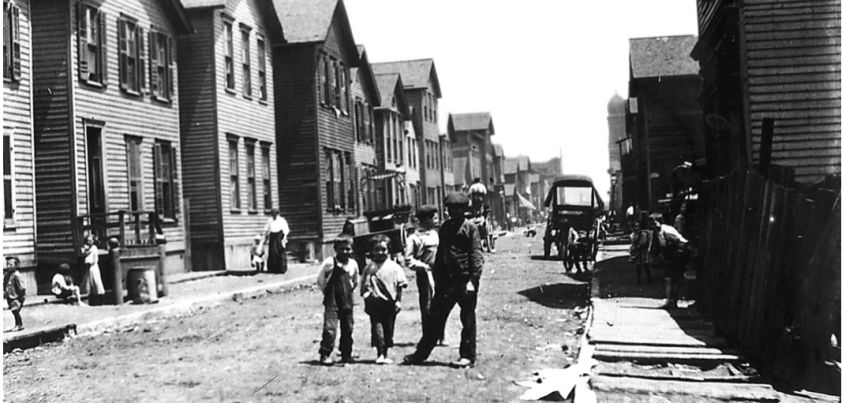 The major themes of this Sharona Vedol story from Spider Magazine are compassion and generosity. Set during the Great Depression, a young girl accompanies her father to collect rent from families in their apartment blocks. She sees first-hand the hardship being experienced by tenants, and is impressed by the respect and understanding her father shows for each family. She is shocked when they come to a family who have no money left over for food, and worries her father will be angry about something she buys with the two dollars he gives her to buy them groceries. More…
The major themes of this Sharona Vedol story from Spider Magazine are compassion and generosity. Set during the Great Depression, a young girl accompanies her father to collect rent from families in their apartment blocks. She sees first-hand the hardship being experienced by tenants, and is impressed by the respect and understanding her father shows for each family. She is shocked when they come to a family who have no money left over for food, and worries her father will be angry about something she buys with the two dollars he gives her to buy them groceries. More…
Category Archives: Grade 3-4 Stories
A Fish Named Dog
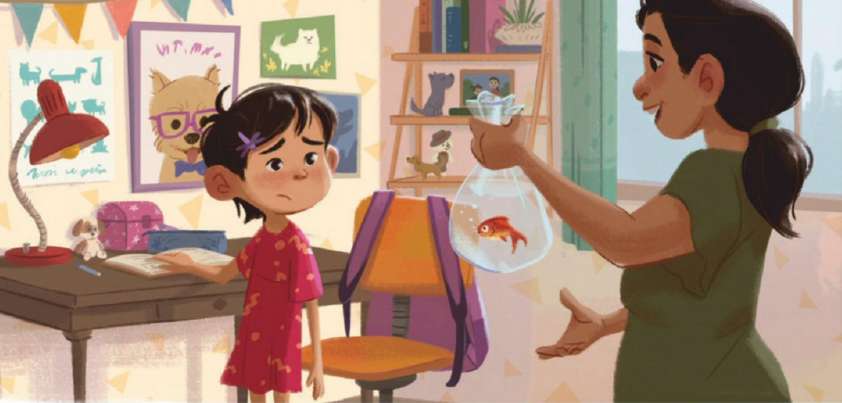 Like many children, the girl in this story by Christyne Morrell for Spider Magazine dreams of having a pet dog or cat. Unfortunately, this is not to be. Her parents give her a goldfish instead! To make sure her mother and father know what she really wanted, she names the fish “Dog.” This must have hurt the fish’s feelings because, much to the girl’s surprise, it begins to live up to its new name. By the end of the story the girl and fish are happy, her friends are amazed, and some readers may never want to eat fish again. More…
Like many children, the girl in this story by Christyne Morrell for Spider Magazine dreams of having a pet dog or cat. Unfortunately, this is not to be. Her parents give her a goldfish instead! To make sure her mother and father know what she really wanted, she names the fish “Dog.” This must have hurt the fish’s feelings because, much to the girl’s surprise, it begins to live up to its new name. By the end of the story the girl and fish are happy, her friends are amazed, and some readers may never want to eat fish again. More…
What the Old Man Does is Always Right
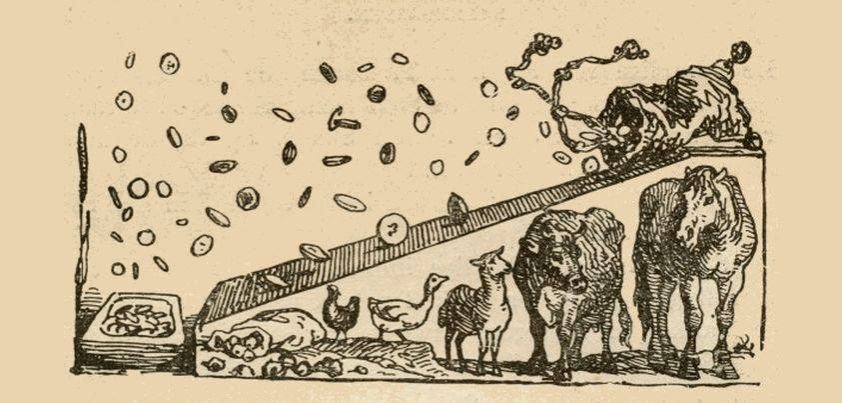 This story by Hans Christian Andersen is about an old man and his loving wife who never sees a problem with anything he does. The only thing they own of any value is a horse, which they decide to sell or trade for something more useful. The man sets off for town and, after several trades along the way, comes home with a bag of rotten apples. As always, his wife was delighted with the result. Andersen called this story one of his best ever tales… but was it really his work? More…
This story by Hans Christian Andersen is about an old man and his loving wife who never sees a problem with anything he does. The only thing they own of any value is a horse, which they decide to sell or trade for something more useful. The man sets off for town and, after several trades along the way, comes home with a bag of rotten apples. As always, his wife was delighted with the result. Andersen called this story one of his best ever tales… but was it really his work? More…
Shells
 In Shells by Cynthia Rylant, a recently orphaned boy named Michael is having problems adjusting to living with his aunt Esther. She has never had children, and is very set in her ways. Michael feels alone in the world. He misses his parents, and goes to a new school where he has no friends. Desperate for company, Michael looks in a pet store for ‘some small living thing’ to brighten up his life. He finds just the right pet. When Aunt Esther shows an interest in it, both Michael and the pet start to come out of their shells. More…
In Shells by Cynthia Rylant, a recently orphaned boy named Michael is having problems adjusting to living with his aunt Esther. She has never had children, and is very set in her ways. Michael feels alone in the world. He misses his parents, and goes to a new school where he has no friends. Desperate for company, Michael looks in a pet store for ‘some small living thing’ to brighten up his life. He finds just the right pet. When Aunt Esther shows an interest in it, both Michael and the pet start to come out of their shells. More…
The Velveteen Rabbit
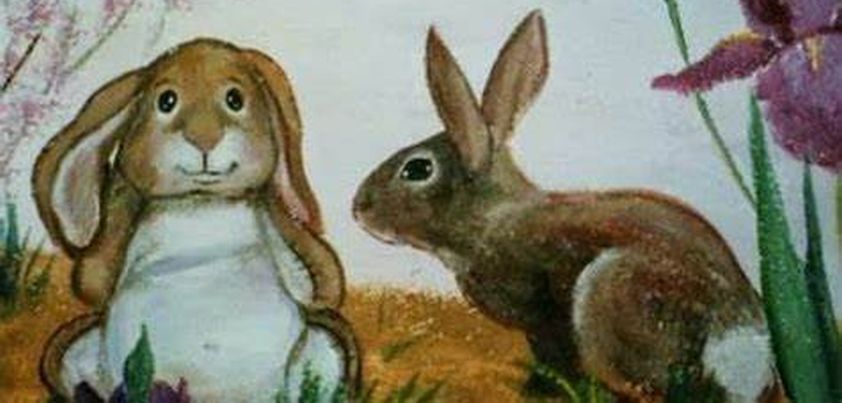 The major theme of this touching children’s fantasy (aka How Toys Become Real) from Margery Williams is the transforming power of love. A cheaply made stuffed toy (Rabbit) is made to feel inferior by the more “advanced” toys in the nursery. A wise but badly worn old toy (Skin Horse) gives it some memorable advice: Real isn’t how you are made. It’s a thing that happens to you. When a child [someone] loves you for a long, long time, not just to play with, but REALLY loves you, then you become Real. Other themes: being different, rejection, hope, loss, fulfillment. More…
The major theme of this touching children’s fantasy (aka How Toys Become Real) from Margery Williams is the transforming power of love. A cheaply made stuffed toy (Rabbit) is made to feel inferior by the more “advanced” toys in the nursery. A wise but badly worn old toy (Skin Horse) gives it some memorable advice: Real isn’t how you are made. It’s a thing that happens to you. When a child [someone] loves you for a long, long time, not just to play with, but REALLY loves you, then you become Real. Other themes: being different, rejection, hope, loss, fulfillment. More…
The Cherry Tree
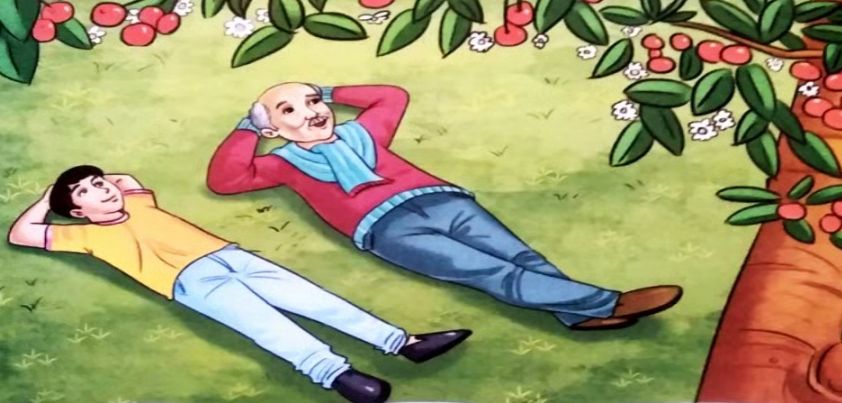 The Cherry Tree from Ruskin Bond contrasts the enduring cycles of nature with the changing world of man. An allegory of parenthood in which a young boy plants a cherry seed and watches as it grows into a tree. He nurtures and protects the tree and, once it is grown, asks: What’s so special about this tree? When his grandfather answers that it’s because they planted it themselves, he responds with pride: is this what it feels to be God? Themes: the beauty and bounty of nature, change, growth, responsibility, caring, achievement, pride. More…
The Cherry Tree from Ruskin Bond contrasts the enduring cycles of nature with the changing world of man. An allegory of parenthood in which a young boy plants a cherry seed and watches as it grows into a tree. He nurtures and protects the tree and, once it is grown, asks: What’s so special about this tree? When his grandfather answers that it’s because they planted it themselves, he responds with pride: is this what it feels to be God? Themes: the beauty and bounty of nature, change, growth, responsibility, caring, achievement, pride. More…
The Champion of Quiet
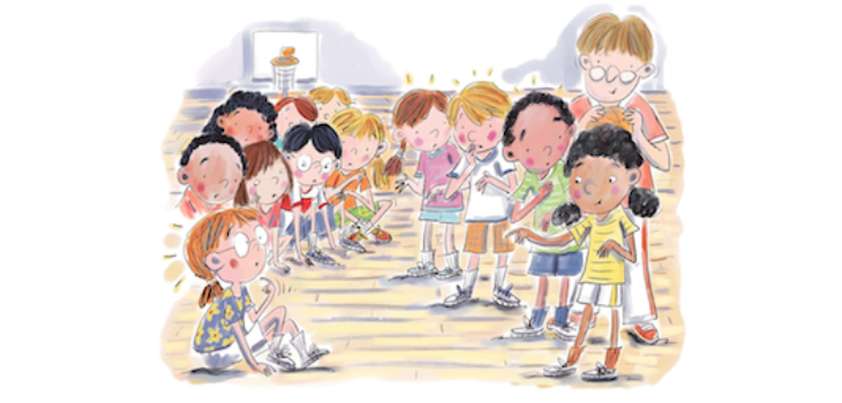 This story by Tracy Stewart for Highlights Magazine includes a number of important life lessons for young learners. The first is individual differences. Nobody is good at everything, but almost everybody is good at something. Importantly, you don’t have to be good at something to enjoy it. By joining in and trying your best, you can have just as much fun as those who are great at it. Maggie proved that she wasn’t just the Champion of Quiet. She became the Champion of Understanding and Kindness, and learned that this is the easiest way of all to make new friends. More…
This story by Tracy Stewart for Highlights Magazine includes a number of important life lessons for young learners. The first is individual differences. Nobody is good at everything, but almost everybody is good at something. Importantly, you don’t have to be good at something to enjoy it. By joining in and trying your best, you can have just as much fun as those who are great at it. Maggie proved that she wasn’t just the Champion of Quiet. She became the Champion of Understanding and Kindness, and learned that this is the easiest way of all to make new friends. More…
Festival of Eid / Idgah
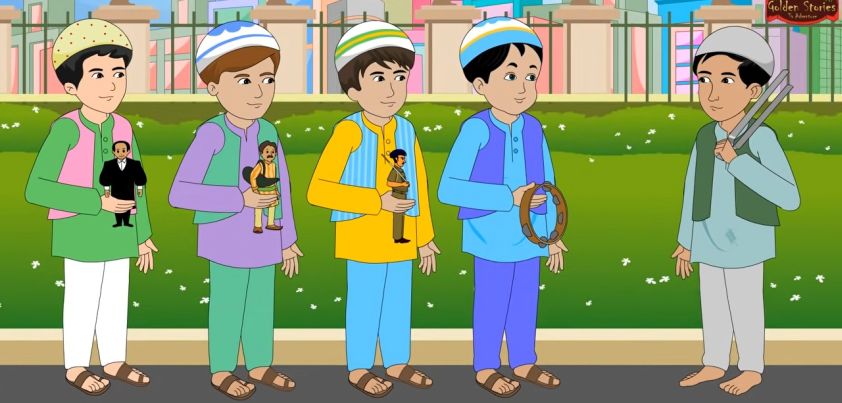 In this well-known Indian children’s story from Premchand, a young orphan foregoes the pleasures enjoyed by friends at a festival to buy a pair of tongs to prevent his poverty-stricken grandmother from burning her hands when cooking. The most obvious themes are related to the boy: poverty, innocence, hope, love, selflessness, temptation and willpower. However, at around 5,000 words, the story also highlights several additional issues. The boy’s friends display materialism and greed, while other themes include religious devotion, superstition (Jinns), village vs. city life and, through the fate of the dolls, the fall of British colonialism. More…
In this well-known Indian children’s story from Premchand, a young orphan foregoes the pleasures enjoyed by friends at a festival to buy a pair of tongs to prevent his poverty-stricken grandmother from burning her hands when cooking. The most obvious themes are related to the boy: poverty, innocence, hope, love, selflessness, temptation and willpower. However, at around 5,000 words, the story also highlights several additional issues. The boy’s friends display materialism and greed, while other themes include religious devotion, superstition (Jinns), village vs. city life and, through the fate of the dolls, the fall of British colonialism. More…
The Enchanted Buffalo
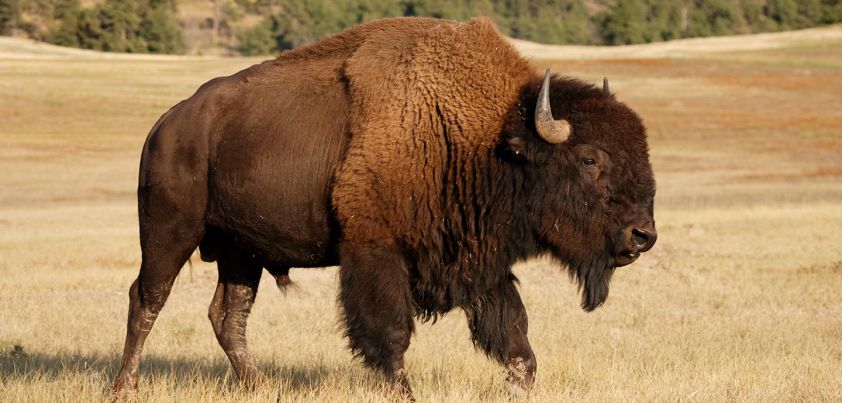 Contrary to the title, this story by L Frank Baum is about events that took place in a herd of American bison, not buffalos. With help from Pagshat, the “Evil Genius of the Prairies”, a treacherous bull kills his herd’s aging and much loved king. After defeating four challengers for the position, he is declared the new leader. His only remaining threat is the young son of the old king who, with more help from Pagshat, he plans to eliminate before he reaches maturity. Themes include aging, greed, betrayal, magic/the supernatural. More…
Contrary to the title, this story by L Frank Baum is about events that took place in a herd of American bison, not buffalos. With help from Pagshat, the “Evil Genius of the Prairies”, a treacherous bull kills his herd’s aging and much loved king. After defeating four challengers for the position, he is declared the new leader. His only remaining threat is the young son of the old king who, with more help from Pagshat, he plans to eliminate before he reaches maturity. Themes include aging, greed, betrayal, magic/the supernatural. More…
The Patient Cat
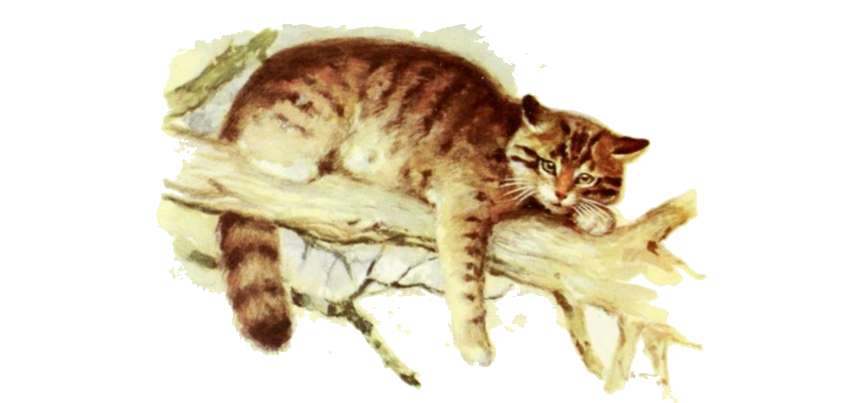 This short fable by Laura E. Richards teaches a lesson about patience. The cat showed patience in waiting for the bird to lay all of its eggs, and then waiting until the eggs had hatched. It also showed patience in not pouncing as soon as the chicks were born, but leaving them until they started to get fat. There was a point shortly after this where the cat should have enjoyed its meal. This leads to the moral of the story: being patient is a good thing, but it is equally important to know the right time to act. More…
This short fable by Laura E. Richards teaches a lesson about patience. The cat showed patience in waiting for the bird to lay all of its eggs, and then waiting until the eggs had hatched. It also showed patience in not pouncing as soon as the chicks were born, but leaving them until they started to get fat. There was a point shortly after this where the cat should have enjoyed its meal. This leads to the moral of the story: being patient is a good thing, but it is equally important to know the right time to act. More…
Stray
 Heavy snow can cause many problems, closing roads and stopping people from going to work or school. Today’s story from Cynthia Rylant is about Doris, an only child from a poor family. A cold, shivering puppy comes into her yard as she is clearing snow from around the front door. It has been abandoned. She takes the animal inside and cares for it, knowing that her parents will say they don’t have the money to keep a dog and take it away when the snow clears. The story’s themes are loneliness, compassion, responsibility, understanding, cruelty to animals, kindness and love. More…
Heavy snow can cause many problems, closing roads and stopping people from going to work or school. Today’s story from Cynthia Rylant is about Doris, an only child from a poor family. A cold, shivering puppy comes into her yard as she is clearing snow from around the front door. It has been abandoned. She takes the animal inside and cares for it, knowing that her parents will say they don’t have the money to keep a dog and take it away when the snow clears. The story’s themes are loneliness, compassion, responsibility, understanding, cruelty to animals, kindness and love. More…
A Child’s Dream of a Star
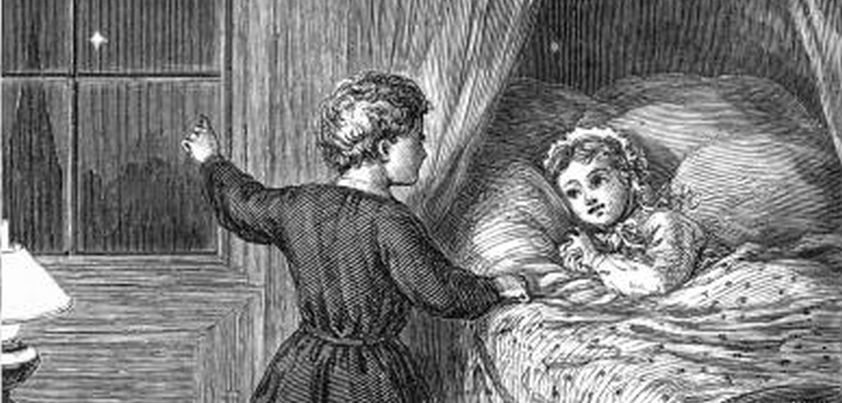 A major theme of this heart-warming 19th Century children’s story from Charles Dickens is what comes after death. Although children today are more likely to have been exposed to the concept of the hereafter than their 1871 counterparts, the story is still used as a reading text in many grade schools. In addition to being a beautifully written piece of prose, it contains several other important themes. These include: 1) the wonder and interdependence of the natural world; 2) brother & sisterly love and devotion; 3) the importance of family; and 4) how life can sometimes seem unfair. More…
A major theme of this heart-warming 19th Century children’s story from Charles Dickens is what comes after death. Although children today are more likely to have been exposed to the concept of the hereafter than their 1871 counterparts, the story is still used as a reading text in many grade schools. In addition to being a beautifully written piece of prose, it contains several other important themes. These include: 1) the wonder and interdependence of the natural world; 2) brother & sisterly love and devotion; 3) the importance of family; and 4) how life can sometimes seem unfair. More…
The Legend of the Christmas Rose
 The major themes of this Christmas story from Selma Lagerlöf are faith, forgiveness, redemption and, of course, the supernatural (the miracle of the Christmas garden). When the wife of an infamous outlaw is discovered admiring a monastery’s herb garden, she tells its Abbot that his prized garden is nothing compared to the one that emerges from the snow outside their forest hideout each Christmas Eve. In the hope of getting her husband pardoned, she agrees to lead the Abbot to see the miracle. Other themes: judging by appearances, mistrust, and materialism (the idea that the poor are closer to God). More…
The major themes of this Christmas story from Selma Lagerlöf are faith, forgiveness, redemption and, of course, the supernatural (the miracle of the Christmas garden). When the wife of an infamous outlaw is discovered admiring a monastery’s herb garden, she tells its Abbot that his prized garden is nothing compared to the one that emerges from the snow outside their forest hideout each Christmas Eve. In the hope of getting her husband pardoned, she agrees to lead the Abbot to see the miracle. Other themes: judging by appearances, mistrust, and materialism (the idea that the poor are closer to God). More…
The Master Cat; or, Puss in Boots
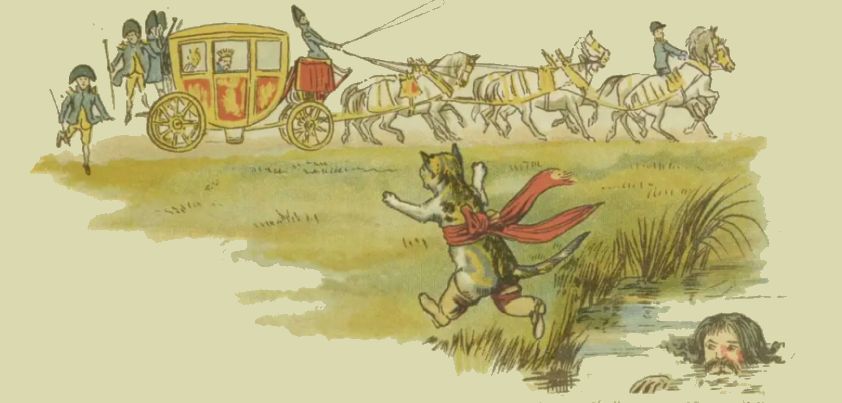 Puss in Boots is sometimes criticized for the mixed message it sends to children. Derived from a 14th Century Italian folktale, a clever cat helps its slow-witted master win the heart of a princess through trickery, lies, threats and theft. To condemn the story because of this seems a little unfair, since folklore is full of likeable tricksters whose crimes are far worse than the cat’s. These characters often play an important role, challenging traditional beliefs through satire. Here, the cat’s actions show up both the greed and gullibility of the king and the shallowness of his daughter. More…
Puss in Boots is sometimes criticized for the mixed message it sends to children. Derived from a 14th Century Italian folktale, a clever cat helps its slow-witted master win the heart of a princess through trickery, lies, threats and theft. To condemn the story because of this seems a little unfair, since folklore is full of likeable tricksters whose crimes are far worse than the cat’s. These characters often play an important role, challenging traditional beliefs through satire. Here, the cat’s actions show up both the greed and gullibility of the king and the shallowness of his daughter. More…
The Magic Sweet Shop
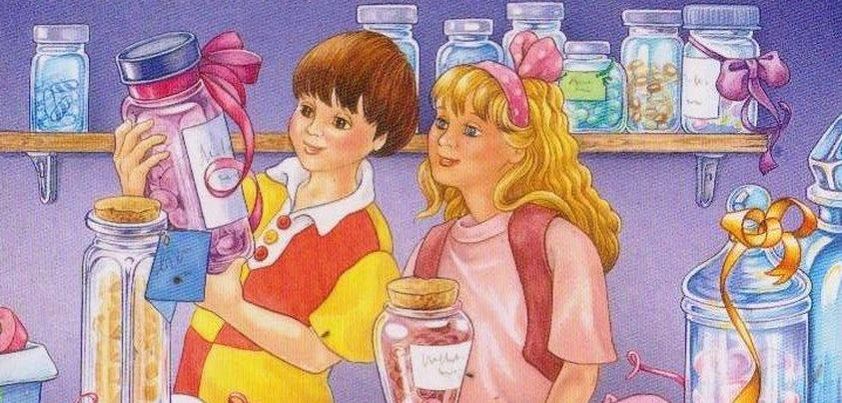 In this story by Enid Blyton, two children out playing in the woods follow a path they had not seen before. It leads to a small village in which there is a strange candy shop. They each buy five different colored sweets with unusual names: a Giant-sweet, Dwarf-sweet, Invisible-sweet, Spiky-sweet and Home-again-sweet. They then have some exciting adventures in which the candy they bought saves the day. As might be expected, the Home-again-sweet leads them home. When they take their mother to the path that led them to the village, they find that it is no longer there. More…
In this story by Enid Blyton, two children out playing in the woods follow a path they had not seen before. It leads to a small village in which there is a strange candy shop. They each buy five different colored sweets with unusual names: a Giant-sweet, Dwarf-sweet, Invisible-sweet, Spiky-sweet and Home-again-sweet. They then have some exciting adventures in which the candy they bought saves the day. As might be expected, the Home-again-sweet leads them home. When they take their mother to the path that led them to the village, they find that it is no longer there. More…
Pret in the House / Ghost Trouble
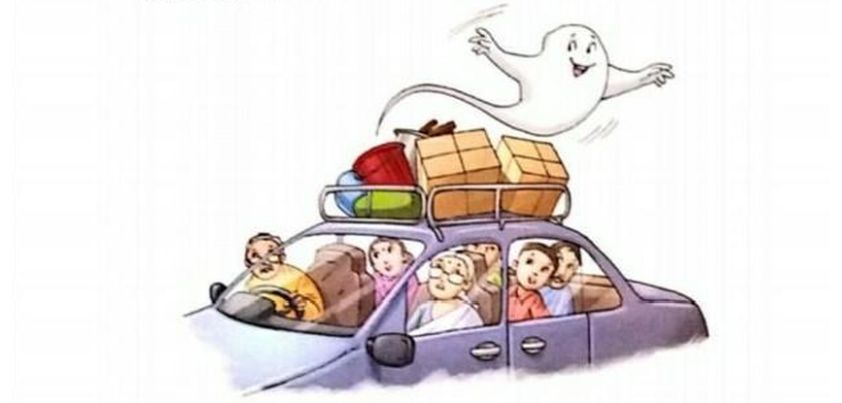 This light-hearted children’s tale from master storyteller Ruskin Bond reflects a once common Indian belief that ghosts and other spirits (pret) inhabit certain types of tree. If something happens to such a tree, these are set free and must find a new home. There are many kinds of pret. Fortunately, the one that moves into a family’s house in this story is of the mischievous rather than dangerous or hungry variety. When its playful pranks become too annoying, the family decides to move away. This does not prove as easy as they thought! Themes: superstition, progress, family connectedness. More…
This light-hearted children’s tale from master storyteller Ruskin Bond reflects a once common Indian belief that ghosts and other spirits (pret) inhabit certain types of tree. If something happens to such a tree, these are set free and must find a new home. There are many kinds of pret. Fortunately, the one that moves into a family’s house in this story is of the mischievous rather than dangerous or hungry variety. When its playful pranks become too annoying, the family decides to move away. This does not prove as easy as they thought! Themes: superstition, progress, family connectedness. More…
In the Great Walled Country
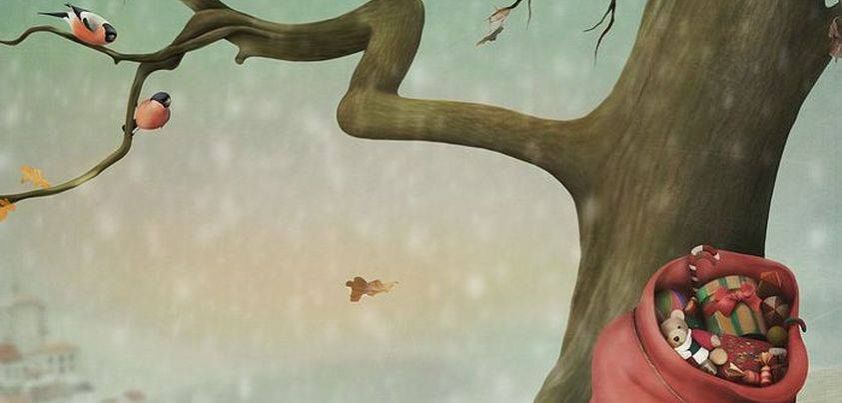 This Christmas story by R. M. Alden tells of a strange land of ice and snow where children never grow up. Being so close to the North Pole, Santa Claus doesn’t deliver presents to people’s houses. He hangs them on trees in a forest. On Christmas Eve, everyone goes out and chooses gifts to give to their family and friends. One year, a stranger visits and convinces the child king that it would be better to change the law so that people collected presents for themselves rather than others. The result was not what he expected. More…
This Christmas story by R. M. Alden tells of a strange land of ice and snow where children never grow up. Being so close to the North Pole, Santa Claus doesn’t deliver presents to people’s houses. He hangs them on trees in a forest. On Christmas Eve, everyone goes out and chooses gifts to give to their family and friends. One year, a stranger visits and convinces the child king that it would be better to change the law so that people collected presents for themselves rather than others. The result was not what he expected. More…
The Golden Windows
 This story by Laura E. Richards is about a poor farm boy who, at the end of most working days, would sit on top of a hill and look at a far-away house that appeared to have golden windows. As he did so, he wished that he could live in a wonderful house like that. One day he sets out to find the house. When he gets there, he is disappointed to learn that the house doesn’t have golden windows. A little girl takes him to the top of her hill and shows him the real house with golden windows. More…
This story by Laura E. Richards is about a poor farm boy who, at the end of most working days, would sit on top of a hill and look at a far-away house that appeared to have golden windows. As he did so, he wished that he could live in a wonderful house like that. One day he sets out to find the house. When he gets there, he is disappointed to learn that the house doesn’t have golden windows. A little girl takes him to the top of her hill and shows him the real house with golden windows. More…
The Selfish Giant
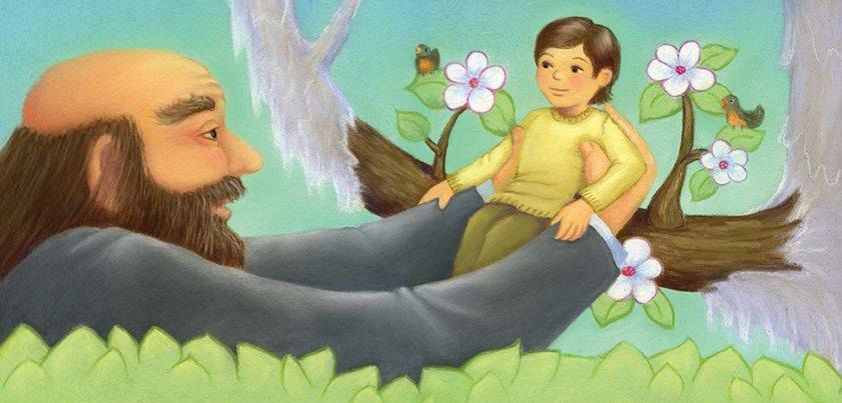 The Irish writer Oscar Wilde is known for his plays, his novel The Picture of Dorian Gray, and his short stories. He also wrote children’s stories, and this is one of the best known of these. A giant finds that his beautiful garden has become a playground for children. He drives them away and builds a wall around it. The seasons close in and his castle becomes a cold, miserable place. Redemption comes in the form of a small child the giant comes to love. The two main themes of the story are greed vs sharing, and Christian love. More…
The Irish writer Oscar Wilde is known for his plays, his novel The Picture of Dorian Gray, and his short stories. He also wrote children’s stories, and this is one of the best known of these. A giant finds that his beautiful garden has become a playground for children. He drives them away and builds a wall around it. The seasons close in and his castle becomes a cold, miserable place. Redemption comes in the form of a small child the giant comes to love. The two main themes of the story are greed vs sharing, and Christian love. More…
The Blind Men and the Elephant
 This children’s story from James Baldwin is based on a religious parable from India. Six blind men come across an elephant for the first time. Although they have often heard about elephants, they have never been close to one. They ask the elephant’s carer if they could try to ‘see’ what it looks like by using their sense of touch. At the end of the story, the blind men are arguing fiercely. Each of them has put their hands on a different part of the elephant’s body. Each of them believes that only he knows what the elephant looks like. More…
This children’s story from James Baldwin is based on a religious parable from India. Six blind men come across an elephant for the first time. Although they have often heard about elephants, they have never been close to one. They ask the elephant’s carer if they could try to ‘see’ what it looks like by using their sense of touch. At the end of the story, the blind men are arguing fiercely. Each of them has put their hands on a different part of the elephant’s body. Each of them believes that only he knows what the elephant looks like. More…
The Tale of the Two Oxen
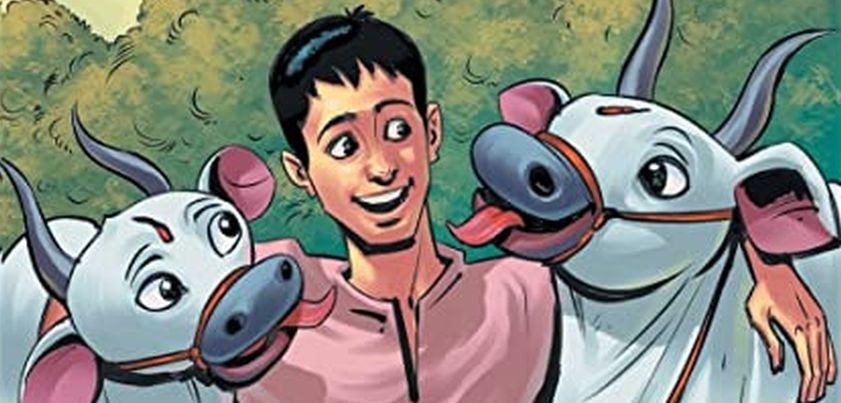 This story by Premchand has three important themes: kindness to animals, friendship and faith. A series of adventures begin for two oxen (Hira and Moti) when Jhuri, their much-loved owner, lends them to his wife’s brother who lives far away. The brother-in-law mistreats the poor animals and, with the help of a kind girl, they run away. Their friendship gives them the strength to endure an attack by a raging bull, beatings and starvation before being sold to a butcher. As they almost lose hope and begin to question their faith in god, a ‘miracle’ helps them return home. More…
This story by Premchand has three important themes: kindness to animals, friendship and faith. A series of adventures begin for two oxen (Hira and Moti) when Jhuri, their much-loved owner, lends them to his wife’s brother who lives far away. The brother-in-law mistreats the poor animals and, with the help of a kind girl, they run away. Their friendship gives them the strength to endure an attack by a raging bull, beatings and starvation before being sold to a butcher. As they almost lose hope and begin to question their faith in god, a ‘miracle’ helps them return home. More…
Sleeping Beauty
 Today we have a reverse chronology of the folktales behind the classic children’s story, Sleeping Beauty. The famous kiss that woke the princess comes from the Brothers Grimm’s Briar-Rose (1812). Charles Perrault’s Sleeping Beauty in the Wood (1697) has no kiss but lots of talk, a hasty wedding followed by a night of “very little sleep”, and an added section where the prince’s mother (an Ogress) decides to make a meal of their children. Perault’s inspiration was the Giambattista Basile’s Sun, Moon and Talia (1634). Here, the king “gathers the first fruits of love” (rapes) the poor unconscious girl. More…
Today we have a reverse chronology of the folktales behind the classic children’s story, Sleeping Beauty. The famous kiss that woke the princess comes from the Brothers Grimm’s Briar-Rose (1812). Charles Perrault’s Sleeping Beauty in the Wood (1697) has no kiss but lots of talk, a hasty wedding followed by a night of “very little sleep”, and an added section where the prince’s mother (an Ogress) decides to make a meal of their children. Perault’s inspiration was the Giambattista Basile’s Sun, Moon and Talia (1634). Here, the king “gathers the first fruits of love” (rapes) the poor unconscious girl. More…
The Giving Tree
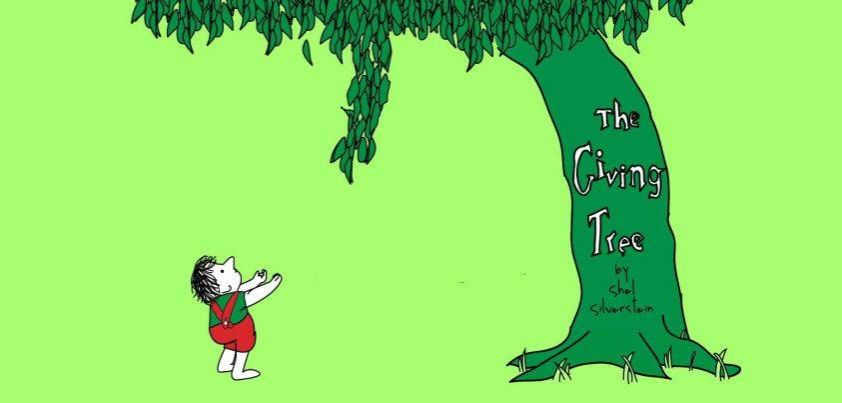 This short children’s story by Shel Silverstein is about a boy who is friends with a tree. He plays under it when he is young, and re-visits it throughout his life. The tree keeps on giving to the boy until it has nothing left to give. The boy does not give anything back to the tree or even say thank you. Readers are left wondering if the closing line And the tree was happy. could possibly be true. If you think of the story as an allegory about a mother’s unconditional love, you will know the answer. More…
This short children’s story by Shel Silverstein is about a boy who is friends with a tree. He plays under it when he is young, and re-visits it throughout his life. The tree keeps on giving to the boy until it has nothing left to give. The boy does not give anything back to the tree or even say thank you. Readers are left wondering if the closing line And the tree was happy. could possibly be true. If you think of the story as an allegory about a mother’s unconditional love, you will know the answer. More…
Little Red Riding Hood
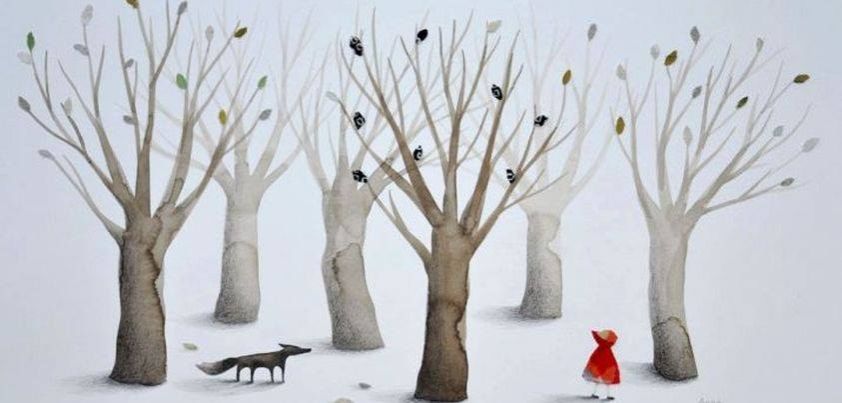 This time last year we featured Charles Perrault’s famous interpretation of an ancient folktale, Cinderella. Today we have another well-known Perrault story, Little Red Riding Hood. The version of the story most commonly told today is from a Brothers Grimm adaption known as Little Red Cap, published over 100 years after Perrault. In both versions, Red is punished for talking to strangers (the wolf) by being “eaten”. The Brothers extended the story to make it more appealing to children. In addition to Red and her grandmother miraculously surviving in the wolf’s stomach, they later meet and kill a second wolf. More…
This time last year we featured Charles Perrault’s famous interpretation of an ancient folktale, Cinderella. Today we have another well-known Perrault story, Little Red Riding Hood. The version of the story most commonly told today is from a Brothers Grimm adaption known as Little Red Cap, published over 100 years after Perrault. In both versions, Red is punished for talking to strangers (the wolf) by being “eaten”. The Brothers extended the story to make it more appealing to children. In addition to Red and her grandmother miraculously surviving in the wolf’s stomach, they later meet and kill a second wolf. More…
Rikki-Tikki-Tavi
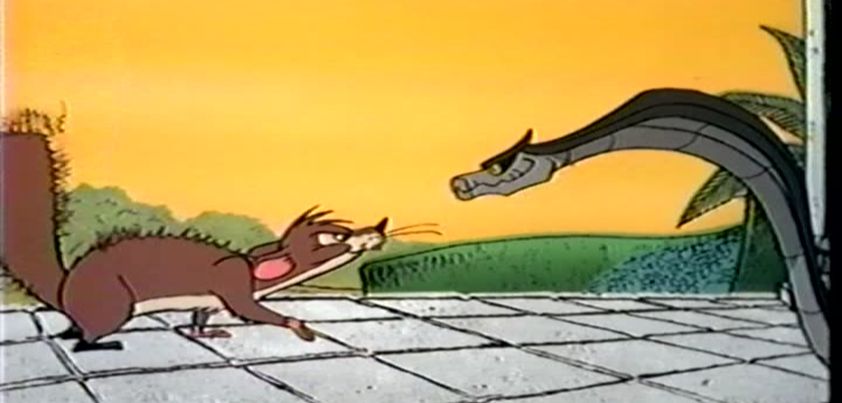 The major themes of this famous children’s story from Rudyard Kipling’s Second Jungle Book are duty, loyalty and courage. When viewed from a Western perspective, the story’s motif is the triumph of good over evil. However, as the cobra is a revered Hindu religious symbol, the plot can also be interpreted as an allegory of colonial conquest: the victory of “benevolent” British imperialists (Teddy and his family) and the Indians who support them (Rikki-tikki) over those resisting domination and change (Nag and Nagaina). Other themes: family, the balance of nature, progress and peace under British colonialism.
The major themes of this famous children’s story from Rudyard Kipling’s Second Jungle Book are duty, loyalty and courage. When viewed from a Western perspective, the story’s motif is the triumph of good over evil. However, as the cobra is a revered Hindu religious symbol, the plot can also be interpreted as an allegory of colonial conquest: the victory of “benevolent” British imperialists (Teddy and his family) and the Indians who support them (Rikki-tikki) over those resisting domination and change (Nag and Nagaina). Other themes: family, the balance of nature, progress and peace under British colonialism.
Kissy Face
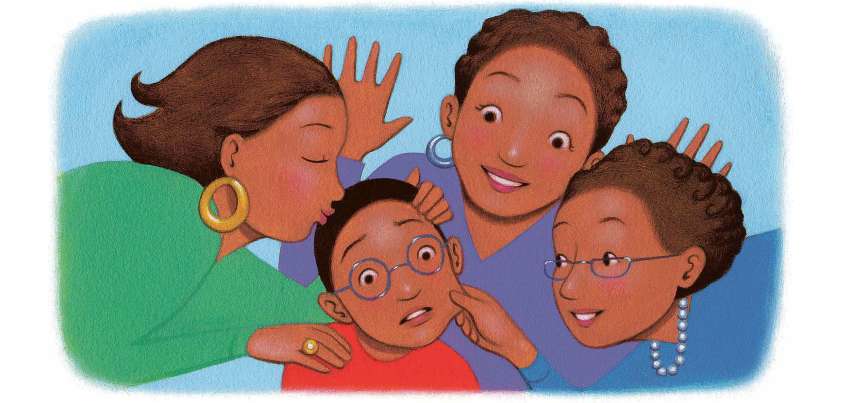 On the surface, this story by Nancy Jean Northcutt for Highlights Magazine is a simple tale about a young boy who doesn’t like being kissed. Like most good stories, it also raises some interesting questions. First, how much of James’s problem with being kissed is because of the hurtful teasing by best friend Ben? Additionally, although James is happy to see the extra attention being given to his new brother now, will he feel the same about this continuing into the future? Finally, how will he handle the extra responsibilities normally expected of the oldest child in a family? More…
On the surface, this story by Nancy Jean Northcutt for Highlights Magazine is a simple tale about a young boy who doesn’t like being kissed. Like most good stories, it also raises some interesting questions. First, how much of James’s problem with being kissed is because of the hurtful teasing by best friend Ben? Additionally, although James is happy to see the extra attention being given to his new brother now, will he feel the same about this continuing into the future? Finally, how will he handle the extra responsibilities normally expected of the oldest child in a family? More…
Cinderella
 Cinderella, perhaps the world’s best-known children’s story, has its origins in folklore. The version immortalized by Disney was first published in Charles Perrault’s 1697 book Stories or Tales from Times Past, with Morals, also known as Tales of Mother Goose. (Yes, Mother Goose was a man!) There are said to be over 1,000 variants of the story across the world. Perrault took the original framework, which has been around since the days of the pharaohs, and added the three elements for which his version is famous today: a fairy godmother, a pumpkin-carriage, and glass slippers. More…
Cinderella, perhaps the world’s best-known children’s story, has its origins in folklore. The version immortalized by Disney was first published in Charles Perrault’s 1697 book Stories or Tales from Times Past, with Morals, also known as Tales of Mother Goose. (Yes, Mother Goose was a man!) There are said to be over 1,000 variants of the story across the world. Perrault took the original framework, which has been around since the days of the pharaohs, and added the three elements for which his version is famous today: a fairy godmother, a pumpkin-carriage, and glass slippers. More…
The Pig That Went to Market
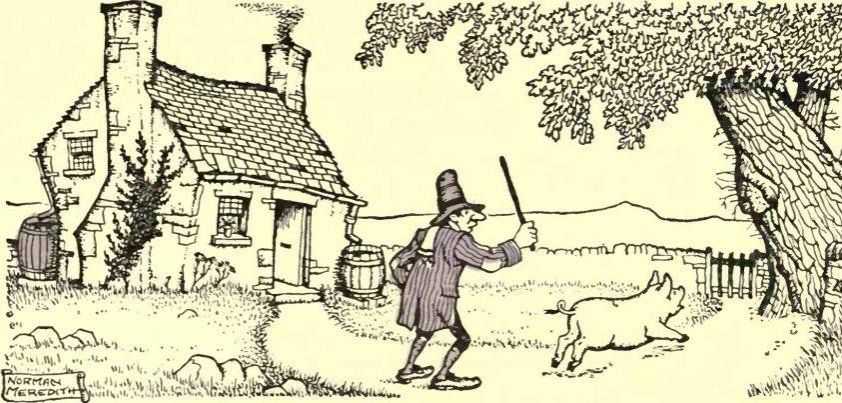 This children’s story by Enid Blyton tells of a man who is so forgetful that he always leaves his kitchen door open. His pig knows this and spends most of its time sitting inside in front of the fire. One day the man finds that he has no money. He decides that selling the pig is a better idea than getting a job. However, his forgetfulness causes problems in taking the pig to market. When he finally does get it there, he receives a beating for his trouble. In the end, he faces an easy decision. More…
This children’s story by Enid Blyton tells of a man who is so forgetful that he always leaves his kitchen door open. His pig knows this and spends most of its time sitting inside in front of the fire. One day the man finds that he has no money. He decides that selling the pig is a better idea than getting a job. However, his forgetfulness causes problems in taking the pig to market. When he finally does get it there, he receives a beating for his trouble. In the end, he faces an easy decision. More…
A Tiger in the House
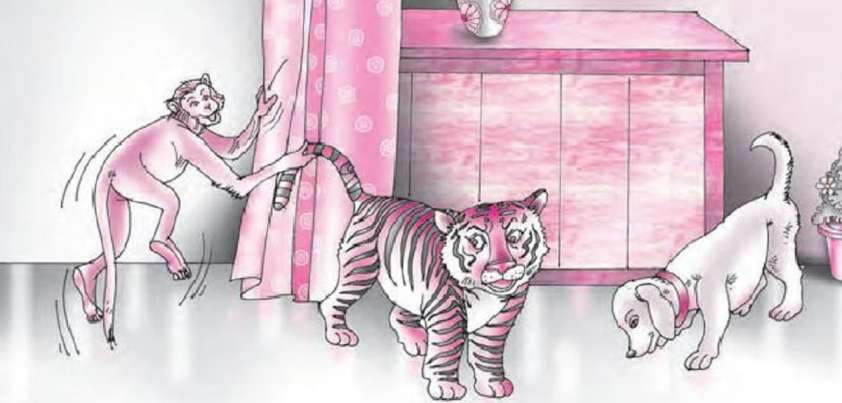 In this story by Ruskin Bond, an old man finds what appears to be an orphan tiger cub in the jungle and takes it home as a family pet. After six months, the cub grows out of its ‘playful’ stage and starts to become less friendly. The old man donates the tiger to a zoo, and gets an unexpected surprise when he visits it six months later. The story raises serious questions as to whether the man’s two decisions (to take the tiger cub home, and to give the grown animal to a zoo) were in the animal’s best interests. More…
In this story by Ruskin Bond, an old man finds what appears to be an orphan tiger cub in the jungle and takes it home as a family pet. After six months, the cub grows out of its ‘playful’ stage and starts to become less friendly. The old man donates the tiger to a zoo, and gets an unexpected surprise when he visits it six months later. The story raises serious questions as to whether the man’s two decisions (to take the tiger cub home, and to give the grown animal to a zoo) were in the animal’s best interests. More…